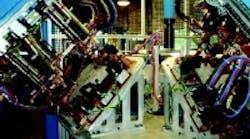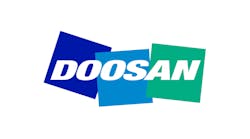A four-station, 34-gun, nine-transformer turntable welder for automotive seatback assemblies (top) and a six-gun, programmable, XY servo welder (bottom) made by Imax Industries Inc. (www.imaxindustries.com)
Engineer-to-order (ETO) manufacturers produce unique products designed to customer specifications. Dies, tools, molds and machine tools are typical examples. For most engineer-to-order manufacturers, every product sold is similar to, yet different from, anything else they previously engineered and built.
A typical engineer-to-order product requires many services delivered, and thousands of parts procured or fabricated. Significant information flow is necessary to monitor, control and replan as required. The lack of information integration between bidding and estimating, engineering, manufacturing and procurement, project accounting and project management found in many engineer-to-order companies can severely compromise the timeliness and accuracy of this critical information flow.
Engineer-to-order products usually are complex and, unlike repetitively manufactured products, customers are involved extensively throughout the design and manufacturing processes. The steady stream of engineering changes, and rework that results makes project planning and control difficult.
Engineer-to-order manufacturers face intense pressures to reduce costs and shorten cycle times, while maintaining high quality. The ETO Institute (www.etoinstitute.org) points out that, to stay competitive, domestic engineer-to-order and projectbased manufacturers must turn to technology to stay competitive. However, their special business challenges cannot be resolved by traditional, repetitive-manufacturing solutions.
Looking to technology
Engineer-to-order manufacturers have found that one of the keys to successfully compete with offshore manufacturers is to use pertinent technology, such as enterprise resource planning (ERP), computer aided design (CAD), customer relationship management (CRM), product-management and configuration software. While many engineer-to-order companies may not think twice about spending $250,000 on new equipment to make their plants more efficient, many balk at spending the same amount on ERP software that could have a more dramatic bottom-line impact than a single machine tool.
The ETO Institute recommends that manufacturers investigate three levels of technology to help achieve their business goals. First, point solutions, such as CAD systems for the engineering department, to improve the accuracy and speed of engineering functions or project-management software may be needed to plan and control projects. Second, manufacturers should consider an integrated solution that would allow data to flow seamlessly throughout the organization and give management the timely information it needs to make informed decisions while improving data accuracy and eliminating re-keying of data. Finally, the ETO Institute recommends that manufacturers develop an optimized solution that would encompass a program of continuous improvement while removing nonvalue-added activities, cutting lead times, and driving waste and cost from the organization.
ETO focused ERP
Enterprise resource planning systems integrate all of the major business functions of a manufacturing company. These include sales, engineering, manufacturing, purchasing, planning, inventory, customer relations and accounting. Although there are hundreds of ERP packages on the market, most address repetitive manufacturing requirements and are not suitable for engineer-toorder manufacturers.
The ability to accurately estimate project job costing is essential. A price must be established that is competitive and allows a profit. To ensure that profit margins are maintained, all costs must be allocated to a project and tracked against the original estimate. Also, it is necessary to know the estimated cost to complete — what is still needed to deliver the project — as the project moves through the manufacturing cycle. Unfortunately, most standard ERP systems address material planning and repetitive production. Since they usually require detailed lists of parts, a bill of materials and routing records, most ERP systems are of little help to engineer-to-order manufacturers when they are constructing an estimate.
As important as accurately determining project profitability is the need for an early-warning mechanism that would indicate when delays or changes occur that could cause a project to go over budget. These crucial engineer-to-order ERP warning systems allow for immediate corrective actions to maintain profitability.
Large engineer-to-order manufacturers, that have many active projects with long lead times, require project-management capabilities to plan and schedule the stages of a project and communicate these to customers. The ability to know if a project is on schedule and on budget is essential. Just as crucial is the need to have visibility of potential problems or overruns so they could be corrected before costs escalate. Project management and the ability to collect and report costs and estimate-to-complete are capabilities found only in a few ERP systems designed to meet engineerto-order needs.
Strategies for success
Successful engineer-toorder manufacturers have developed new business strategies rather than relying on old business models that may be better suited to repetitive manufacturing. For instance, successful engineer-to-order manufacturers do not compete with commodity machine builders, but rather develop niche-market expertise that creates product and industry-sector distinction. Typically, larger, more expensive machines need more services and support, and generate alternative revenue streams.
In addition to developing niche expertise, engineer-to-order manufacturers often find that new markets offer exceptional opportunities. For instance, overseas markets represent a huge potential for engineer-to-order manufacturers. Even untapped domestic sectors, such as transplant automotive factories that require automation, are good prospects. Also, aftermarket services are required throughout the life of the product, and the sale of spare parts can be a significant part of the manufacturer's business.
Often, for engineer-to-order manufacturers, payment is received after the one-of-a-kind product is installed at the customer's site. To maintain acceptable cash flow in spite of the typically long lead times involved, many engineer-to-order manufacturers use progressive billings so that they receive partial payments, usually based on a percentage of the total bill, when a significant milestone is reached.
| Repetitive program | ETO program |
| Price list | Project estimates and quotes |
| Standard products | Unique, one-of-a-kind products |
| Sales order | Job order |
| Standard cost | Actual cost |
| Purchase material to stock | Purchase material to project |
| Ship from finished goods | Ship from work-in-progress |
| Leadtimes — days/weeks | Leadtimes — months/years |
| High-volume production | Low-volume production |
| Invoice on delivery | Progress billing by milestones |
| Focus on material planning | Focus on production scheduling |
| Forecast driven | Project driven |
| Plan with master schedule | Plan with project management |
| Standard MRP | MRP by project |
| Delivery to customer | Installation on site |
| Part-number based | Job-order based |
| Design completed before production | Design integral part of production |
| Few engineering changes | High number of engineering changes |
| Cost variances to standard | Cost variances to original estimate |
| Flat bills of materials | Deep bills of materials |
| How repetitive and engineer-to-order manufacturing differ, according to Thomas R. Cutler of TR Cutler Inc.. | |
Integrating For ETOAutomatic Feed Co. (www.automaticfeed.com), a manufacturer of coil handling and press feeding automation systems in Napoleon, Ohio, is an engineer-to-order company that has special integration requirements. The company needed to increase efficiency and reduce costs because its existing manufacturing system lacked advanced integration capabilities. "We wanted to better integrate our CAD system with the bill-ofmaterials and integrate our sales quoting with our costing and supporting processes," explains Nathan Weaks, AFC treasurer, "We needed to make information about the best manufacturing times that we've done on a job more accessible to the team member involved in making the equipment." AFC also wanted to integrate its QS9000 quality system with the manufacturing system, integrate project management and scheduling to enable tracking and reporting progress on each project, and improve human resources record keeping. This had to be accomplished in six months. AFC chose Encompix Inc. (www.encompix.com) to supply ERP software and services. "Encompix is set up to handle most of the issues that machine tool companies face," says Weaks, "However, we are different from other machine tool makers in that our average project is in the range of $3 million to $5 million with thousands of parts manufactured for any given machine. The Encompix team quickly understood that we were not typical, and they were able to accommodate our unique requirements on time and on budget." Since its implementation, the Encompix system has produced a 20-percent cost reduction and a 30-percent reduction in cycle time. |



